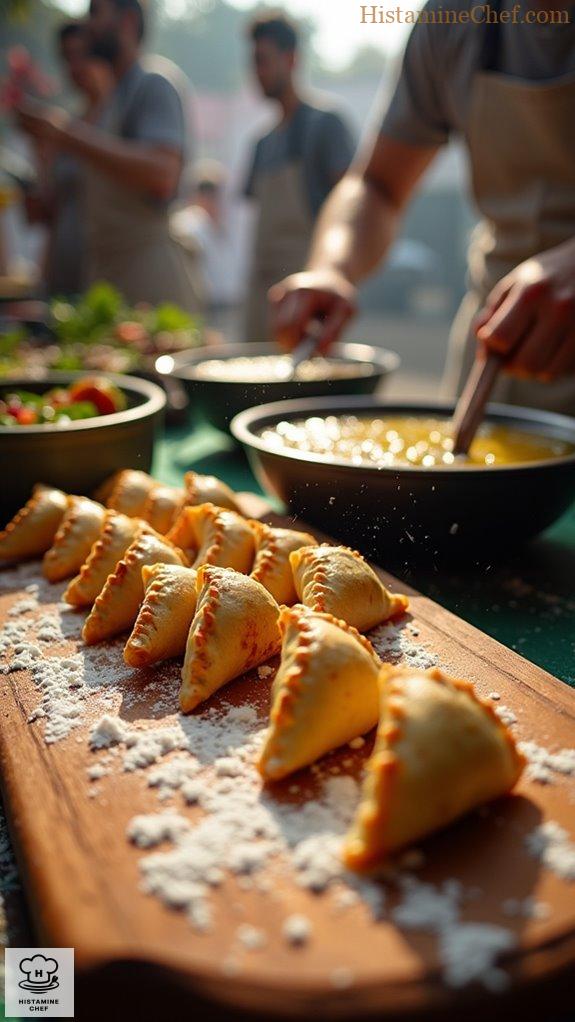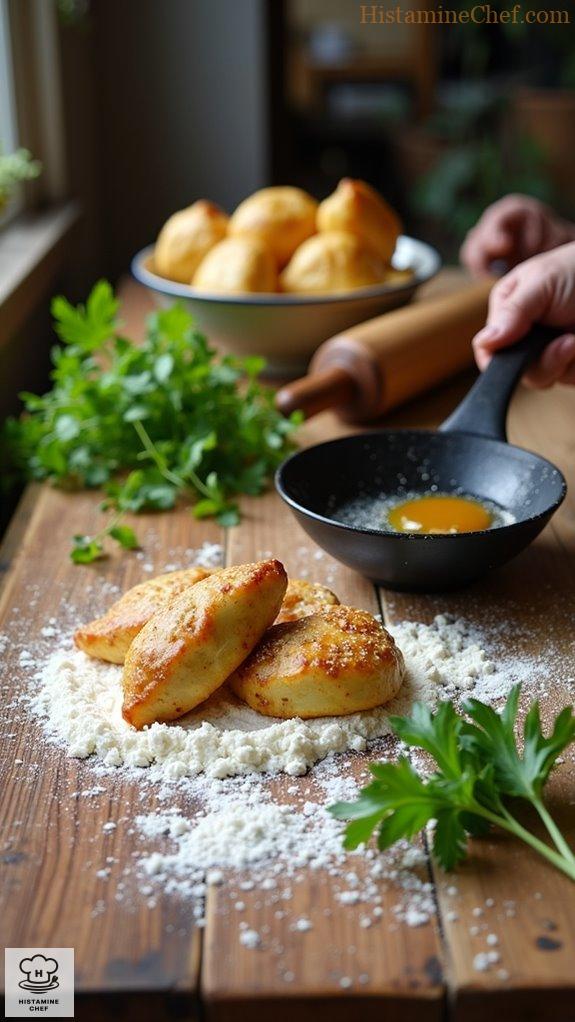If you’ve been missing out on the crispy delight of Pakistani samosas due to histamine issues, I get it—it’s frustrating! But hold onto your taste buds because I’ve got a solution! Start by using quinoa or spelt flour for the dough, and stuff it with boiled potatoes and fresh veggies instead of those histamine-laden ingredients. Fry them up in coconut oil for that perfect crunch. Curious about the step-by-step process? Stick around, I’ve got more tips for you!
Vibrant Street Food Culture

The street food culture in Pakistan, particularly in cities like Lahore, Karachi, and Peshawar, embodies a vibrant tapestry of flavors and culinary traditions shaped by the country’s diverse regional influences.
In Lahore, areas such as Gawalmandi Food Street and Anarkali Bazaar serve as bustling epicenters for iconic delights like paaye and samosas. Street food vendors in these locations are pivotal figures, preserving regional culinary heritage through traditional recipes.
Karachi, known as a melting pot of flavors, showcases a variety of street foods adapted to local tastes, with stalls offering classics like bun kababs and pani puri.
Peshawar stands out for its robust meat-centric offerings, with smokey kebabs and chaamp grilled to perfection using traditional methods.
Historically, street food has thrived in Pakistan since ancient times, serving as a quick, affordable meal choice for workers and families amidst the bustling urban surroundings.
This culinary tradition not only supports local businesses and entrepreneurship but also acts as a social hub that draws both locals and tourists, offering an authentic taste of Pakistan’s rich gastronomic heritage.
As tastes evolve and global influences shape culinary practices, the adaptability and authenticity of street food continue to enhance its appeal, weaving together the narrative of flavor and culture across the nation.
Deep-Fried in Bubbling Oil

To cook Pakistani samosas on the street, vendors first heat a large, deep frying pan filled with fresh oil at a prime temperature between 340°F (170°C) and 365°F (185°C) to guarantee a crispy texture.
They test the oil by dropping a small piece of dough to check if it floats quickly, indicating readiness. After fully preheating the oil, they carefully add samosas in small batches to avoid overcrowding.
Initially, they fry at a lower temperature to set the crust and then increase the heat for final crisping. Throughout the process, they avoid disturbing the samosas initially to prevent leaks.
Once golden-brown, they drain the samosas on wire racks to allow excess oil to drip away and serve them immediately for the best texture.
Ingredients:
- 2 cups all-purpose flour
- 1/2 tsp salt
- 1/4 cup vegetable oil
- 1/2 cup water
- 1 cup spiced potato filling
- Fresh mint chutney (for serving)
- 4 cups cooking oil (for frying)
- Optional sesame seeds (for garnish)
Cooking Steps:
- Mix flour and salt in a bowl.
- Add oil, then slowly incorporate water.
- Knead until smooth, then rest dough.
- Prepare spiced potato filling separately.
- Roll out dough and cut into circles.
- Fill each circle with potato filling.
- Fold and seal the edges tightly.
- Fry in hot oil until golden brown.
Samosa Filling Options Explained

To make Pakistani samosas at home, use an allowed filling such as boiled potatoes, seasoned with cumin, coriander, and fresh herbs. Avoid using any restricted ingredients like peas or any dals. For the dough, opt for all-purpose flour or spelt flour instead of refined flour, and avoid adding any spices known to be high in histamine. Make certain to use coconut oil for frying instead of traditional oils, and serve with homemade apple chutney instead of store-bought sauces. Allow your samosas to fry until golden and crispy, adjusting temperatures to achieve a nice crunch without burning.
Changes for Home Cooking:
- Use spelt flour for dough.
- Replace restricted seasonings with allowed spices.
- Fry in coconut oil.
- Fill with seasoned boiled potatoes.
- Serve with homemade apple chutney.
- Skip peas and lentils in filling.
- Make certain fresh herbs are used.
Low Histamine Variation of Samosa

Street food is often notorious for being high in histamine due to ingredients that have been fermented, processed, or improperly stored.
Those with histamine intolerance can experience adverse reactions when consuming these foods, making it essential to adapt traditional recipes to meet dietary needs.
Eating street food like samosas can be particularly problematic for individuals with histamine intolerance as many common samosa ingredients score high on the SIGHI list.
For instance, using fermented dairy products, such as yogurts or traditional spices, can elevate histamine levels, potentially causing undesirable symptoms for those sensitive to histamine. Learning to read food labels for hidden histamines can help in selecting safer ingredients.
Low Histamine Variation of Samosa Cooking Instructions:
- Replace traditional flour with spelt flour or quinoa flour for the dough.
- Use fresh vegetables, such as carrots and peas, instead of onion or mushrooms.
- Substitute processed meat with fresh chicken, turkey, or ground beef.
- Avoid adding any fermented sauces or meats to the filling.
- Use fresh spices like coriander leaves instead of restricted spices for flavor.
- Opt for coconut oil or butter for frying instead of any restricted oils.
- Bake instead of frying if desired to reduce added oils and histamine buildup.
- Serve fresh with peppermint tea or water instead of traditional condiments.
- Prepare ahead and consume immediately to minimize histamine formation.
- Store any leftovers in the freezer, away from light, to limit histamine increase.
Video Summary
Pakistani samosas have been a beloved street food for centuries, combining crispy pastry with savory fillings. In this video, we’ll present the authentic street version first. Then, we’ll share a lower histamine home version with necessary adjustments.
Street vendors begin by making the dough. They mix all-purpose flour with a pinch of salt and water until a smooth consistency forms. Next, they knead the dough and let it rest for about thirty minutes.
For the filling, they cook potatoes with spices in a hot pan. Ingredients like cumin, coriander, and green chilies add flavor. Once the potatoes are soft, they mash them and add peas and fresh herbs.
Next, they roll the dough into small balls and flatten them. Vendors then cut these into circles, filling each with the potato mixture. They carefully fold and crimp the edges, sealing in the goodness.
In the end, they fry these samosas in hot oil until golden brown and crisp. The result? A delicious snack bursting with flavors.
Now for the home low histamine version, we swap all-purpose flour for quinoa flour to make the dough. Use a pinch of salt with the flour, and still add water until it’s smooth. Rest the dough as usual.
For the filling, use only boiled potatoes, skipping spices that are high histamine. You can use fresh herbs like cilantro or parsley for taste.
When assembling, follow the same method of filling and sealing the samosas. Use coconut oil for frying instead of regular oil. The final samosa has a golden hue and a delightful crispness. Its taste will intrigue your palate with simple, fresh flavors.
Click the link in the description for the full recipe!
References
- https://trulypakistan.net/pakistani-street-food/
- https://artsandculture.google.com/story/the-street-food-culture-of-pakistan-soch/rwWRASrO8ZHUIQ
- https://iips.com.pk/cuisine-and-tourism-how-pakistani-food-is-attracting-global-foodies/
- https://en.wikipedia.org/wiki/Pakistani_cuisine
- https://togetherwomenrise.org/customsandcuisine/customs-and-cuisine-of-pakistan/
- https://www.whats4eats.com/appetizers/samosas-recipe
- https://tasteasianfood.com/how-to-make-samosa/
- https://www.flourandspiceblog.com/juicy-crispy-keema-samosas-fried-air-fried/
- https://dishesandflavors.com/samosa/comment-page-1/
- https://twoclovesinapot.com/homemade-crispy-pakistani-style-beef-samosa/


Leave a Reply